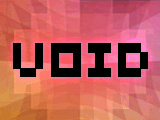Bit.Trip Void Review
|
|
See PixlBit's Review Policies

On 11/28/2009 at 11:02 PM by Lukasz Balicki You won’t want to escape this void. |

If you are a fan of the Bit.Trip series or are interested in games that are both extremely fun and engaging, do not hesitate to download this fantastic game.
Bit.Trip Void is the third game in the Bit.Trip series. Like the first two games, Bit.Trip Void contains three levels that last around fifteen minutes, presentation that mixes both retro and modern elements, as well as fantastic gameplay that’s easy to learn but challenging to master. Aside from the staples of the first two titles, Void includes a few new elements that make it a worthy and excellent addition to the series.

In the game you control a void, represented by a pixilated black hole. The game tasks players with collecting all of the black bits seen on the screen while avoid the white bits. In order to move the void around, players will need to take use of the analog stick on either the Nunchuk or Classic Controller.
Absorbing a black bit allows the void to grow in mass and the player to accumulate a larger score multiplier. If you hit a white bit your void shrinks and your score is reduced by a number of points. As your void grows, it's harder to avoid white bits since the void moves slower and occupies more space on the screen. You are allowed to shrink your void to its original size with the press of a button and when doing so, you are awarded points dependant on how many black bits were absorbed at the time.

If you miss too many black bits, get hit by too many white bits, or a combination of both, you will be sent to a colorless netherworld. This signals that you are on the verge of failing the song. If you perform well enough, you can escape the netherworld. Outside of the netherworld, if you perform exceptionally well, the music and background animation becomes more complex in a similar fashion to the other games in the series.
Given the steep difficulty ramp seen throughout the series, the Gaijin Games decided to add a new checkpoint system to Void to aide players. Each stage has three checkpoints and if you lose during a level, you will be given the opportunity to use a credit to start at the nearest one. Unfortunately, restarting at a checkpoint resets your score, but thankfully it gives players the opportunity to continue enjoying the game. Those who had a hard time with the difficulty of the original games will find Void more palatable thanks to this new system.

The soundtrack is composed by Nullsleep who specializes in 8-bit chiptune music. Keeping with the theme of the game, the soundtrack integrates sounds and music typically found in Atari 2600 games. Void is aurally sublime thanks to the combination of its music and sound effects.
Similar to the other two games, Void implements a very busy graphical style, but one that channels games of the past. At times the backgrounds can be distracting, but clearly this was done on purpose as a means of making the game more challenging as well as more interesting to watch.

Void has made some alterations to the HUD, integrating it into the background. The current level progress, score, and everything else previously in the HUD now simply scrolls in the background. This implementation isn't distracting since the scores never obstruct your view and fit will with the general backgrounds of each stage.
Overall, Bit.Trip Void is one of the best, if not the best entry in the series. While some fans of the series will balk at the inclusion of checkpoints, it ultimately makes the game more accessible and enjoyable. While the gameplay is simple, it’s highly addicting, always pushing players to best their last attempt. Couple this with the fantastic presentation and soundtrack and it’s clear that Bit.Trip Void is undoubtedly one of the best titles available on WiiWare.









Comments